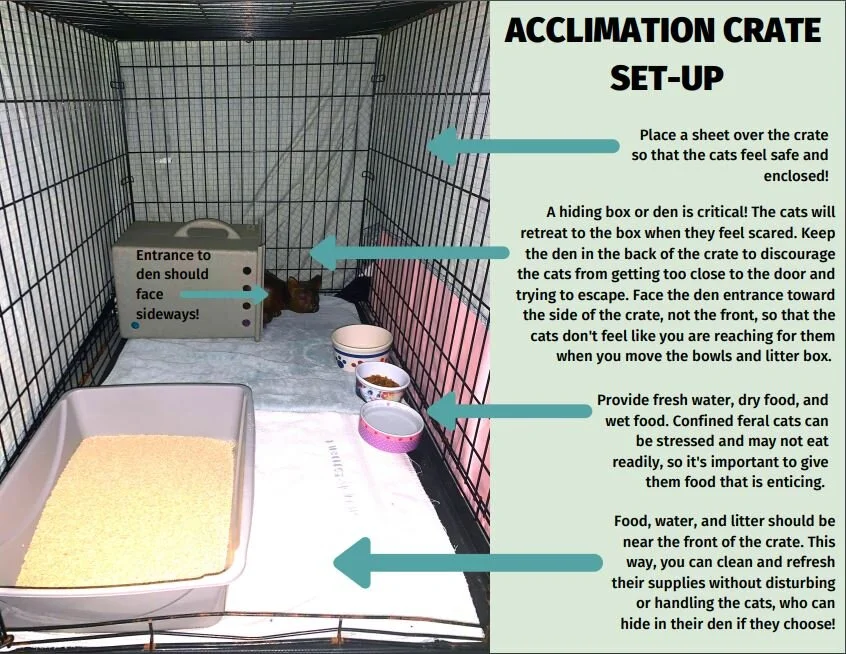How to Acclimate Working Cats to a New Home
Because of the shy, timid, and feral temperaments of Working Cats, we ask that adopters of Operation Catnip working cats spend 2-4 weeks acclimating the cats to their new environments. This involves keeping the cats housed in a crate with a litter box, food and water, and a den to hide in. Small, confined, climate-controlled spaces like tack rooms or workshops are also suitable, as long as the cats can’t escape on their own accord!
Think of this as the “Honeymoon Period!” We’d like adopters to tend to the cats daily, keeping their cages clean and talking to them, so that the cats get used to the voices of their new caregivers. Cats will stay where they feel safe and have resources, and this acclimation period is your time to show the cats that they will be fed and cared for in their new home.
Following this 2-4 week period, adopters will release the cats, and even if they take off in a hurry, they will know the smells, sights, and sounds of their new environment, and return “home” when the excitement of release has worn off!
We are happy to loan out large dog crates, feral cat dens, and litter boxes for this acclimation period, to be returned once the cats have been released!
Releasing the Cats
After the 2-week minimum, assess the cats’ behavior. If the cats don’t seem comfortable, do not release them. It may take up to 4 weeks for the cats to ultimately feel comfortable. The more feral the cat, the longer this process can take, as a less-socialized cat will take longer to bond to a new person and place. If, after 4 weeks, the cats are still not exhibiting the behaviors below, it is recommended to release them anyway. The cats will have had enough time to adjust to the area, but likely have not developed a strong comfort level with their new caregivers yet. These kinds of cats typically thrive on release and will open up more once they have some freedom.
Behaviors that indicate that the cats are ready to be released:
Lounging comfortably in the crate, especially stretched out rather than curled up!
Spending most of their time outside of their “hiding space”
Playing with items inside the crate or with each other
Eating, drinking, or using the litter box in your presence
Meowing or purring in your presence
Making a “mess” by kicking litter out of the box or knocking over food/water bowls
Daytime release is recommended. Place a breakfast of canned cat food in the crate with the cats, and leave the door to the crate open. Walk away and allow the cats to leave the crate on their own. Do not force the cats from the crate. Leave the crate set up as you have had it for an additional week, as the cats may return to the set up as a source of food and comfort. Feed the cats in the same area as the crate. Should you decide to feed the cats on a different area of the property, place their food closer to the target site at each feeding, slowly transitioning them to the new area.
Other Tips
Have a structured feeding time, preferably twice a day. This way, you can expect the cats’ presence at the same time each day, and can take note of their absence if they miss any meals.
Have a “call:” a phrase or word that you use to summon the cats. Something like “here kitties!” or “dinner time!” They generally bond strongly with one or two people, and will respond to the voice of their must trusted humans, especially if they hear the same phrase regularly and associate it with food.
Only leave out enough food that the cats can finish in one sitting. Leaving out large amounts of extra food will attract bugs, predators, wildlife, and other cats.
The cats will typically find their own places of refuge on your property, but you’re also welcome to provide structures of your own specifically for the cats, such as commercially-manufactured cat houses or DIY shelters!
While these cats are typically not wandering up to strangers for attention, it’s a good idea to let your neighbors know that they should expect to see the cats around. It’s normal for sterilized outdoor cats to travel at least 1/4 mile in every direction from their home base, and they will probably frequent other properties, especially if there are other cats there or cat food left out.


